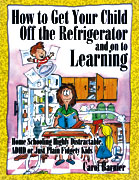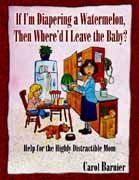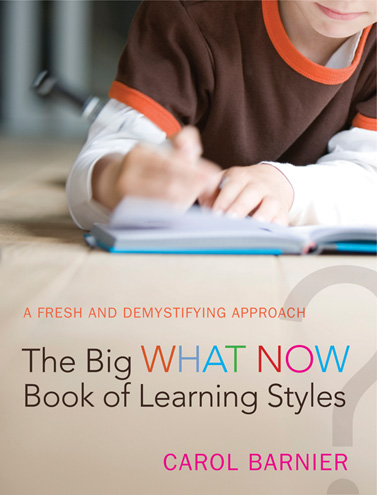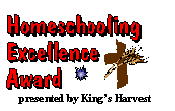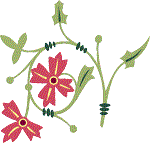
Welcome to Carol's Web Corner
Dedicated to
Teaching and Seeing the Gift in Your Highly Distractible Child.
Top 10 Tips for Teaching ADHD/ADD Children
When I first began homeschooling our ADHD son I searched everywhere for tips on HOW to teach this highly distractible child. I found volumes of information on how to recognize the ADHD child, how to manage the ADHD child, how to medicate them, how to discipline them, and how to accept them. But I found practically nothing on how to teach ADHD/ADD children math or reading on Monday morning.
So I embarked into the world of homeschooling trying to apply typical education strategies to my atypical child. After 6 difficult months, I stopped thinking in terms of "what works for most children" and I finally began to find out what works for MY child. Over the years, we developed teaching tips and strategies in our home school that clearly made a difference -- especially in reading & math. I wished someone had shared some of these teaching tips with me BEFORE we'd had our 6 difficult months. So the purpose of this website is to share our experience in case it may be helpful to others with ADD/ADHD children.
(Just click on a Tip!)
1. Making Math Workbooks WORK!
2. Have Them Do Two Things at Once
3. Allow Them to Respond Orally
4. Integrate Motion into Everything You Can
5. Put Up Visual and Auditory Blinders
6. Phind the Phun in Phonics! (And lots of other places)
7. Don't Do Everything in Every Book
8. Give Your Child a Checklist of the Day's Assignments
10. Forget what others think...SEE THE GIFT IN YOUR CHILD

ADHD Teaching Tip #1
**** Turn a section of math problems into a game. One of the easiest ways to do this is to make a puzzle. My son dives into his math problems whenever I do this.
Take a piece of letter sized paper. On one side, write the answers to a set of math problems (approximately 10). Scatter the answers about on the page in random fashion.
On the flip side of the page, write a note about how special your child is, or give directions to find a secret treasure hidden in the house. Then get out your scissors and start cutting out each of the math answers, shaping each piece in a unique, puzzle-like shape.
Now spread the items all over the floor. When your child completes the first math problem, he picks up the piece with the matching answer. Little by little, the puzzle comes together.
**** Give him work in smaller groups. Place a whole page of math problems in front of these kids and the task before them seems insurmountable. But if they see only one chunk at a time, they don't get overwhelmed by the BIG PICTURE.
One way is to dictate 1 problem at a time. Sometimes I even write 1 problem per sheet of paper if the problem is a bit tedious for him. ( I make each paper 1/4 size of a letter-sized sheet).
Another way is to simply cover portions of the workbook with white paper held in place by that sticky stuff used to hold up posters. Big Post-It notes can also be used. Kids aren't stupid. They know what's under there. But somehow, just having it out of sight often eases the anxiety that a page full of math problems can elicit.

ADHD Teaching Tip #2
Have Them Do Two Things at Once
I used to assume that when I was speaking to my son, if he turned upside down in his seat or began to grab frantically at imaginary flies, then he MUST not be listening. Wrong. Not only is he listening, if I required that he sit perfectly still and look at me intently while I spoke, he most certainly could not listen. In fact, he might implode. He NEEDS to be moving while listening. But if I allow him to choose the motion, it will almost certainly be very distracting to me, or highly annoying to anyone else within range of us (i.e., other children). So I choose the activity. Some of our favorites are:
- playing with silly putty
making salt dough maps or structures related to the lesson One of the neatest was a model of an Ancient Egyptian house during one of our history lessons.
playing with Legos
screwing screws into wood
sweeping & mopping the kitchen floor (this has obvious side benefits.)

ADHD Teaching Tip #3
Writing is sheer torture for many of these kids. And you will find much out there in educational literature about how writing should be part of the whole splendid mix of education from the moment they can grasp a writing utensil. But there are times, for example in doing math, when my son seems almost stuck when he has to write down what he clearly knows. To jump from the "math calculating" part of his brain to the "put thoughts down in writing" part of his brain, seems an impossible task. It's as though there is a wall between these two areas that he cannot traverse. He can take a section of writing and recopy it with no problem. He can dictate to me each and every step of a complicated math problem with great ease. But tie the two together, and a 5 minute task turns into 45.
Luckily, I've read that for most of these "writing-haters" it all comes together in about 4th grade. So unless you are doing a writing lesson, consider allowing an oral response. In other words, in your math lesson, if your child is asked to write the terms of a multiplication problem (multiplicand, multiplier and product...in case you forgot), keep in mind that the object here is to learn the math material...not to practice writing. Writing does not necessarily HAVE TO be incorporated into each and every learning activity.
Many days I will insist he plod through it. I want these two portions of the brain to eventually learn to talk to each other. But there are days when the goal of the lesson...math, is being lost in my efforts to have him connect math and writing. Don't hesitate to isolate the concept being studied if that's what works for your student. If you are not willing to do this, you may find yourself in an unfortunate situation where your child is falling behind in a subject in which he is perfectly capable because you insist he do it in tandem with a subject he isn't capable of handling with ease.

ADHD Teaching Tip #4
Integrate Motion into Everything You Can.
We often play Mother-may-I in our house. I ask each child an age appropriate question. If they answer correctly, I say that they may proceed (using of course baby steps, giant steps, scissors walk, frog leap, etc.). They MUST respond with "Mother-May-I?", to which I reply "Yes", and then they move forward. If they attempt to move forward without asking "Mother, may I?", they must take 2 steps backwards. The first child to reach "Mother" wins. And we start again. By choosing the types of steps carefully, I can be assured that each child gets to win in each play time.
Hop-on-It works with lots of educational objectives. I put cards on the floor with words on them. In one game I put out cards reading, "adjective", "noun", "verb", and "adverb". The I call out a word and my son has to jump on the correct word type. In another version, the cards read "2", "3", "4", and "5". Then I call out 16. He must then jump on a card that is a multiple of this number.
Some other ideas with this format-
- Card types: mammal, amphibian, insect, bird, &
fish.
- Call out: "I have hair". "I have live
births" "I have scales"
- Card types: B, P, D, C, SH, PH
- Call out: the sounds made by these letters. Or a word that
ends with one of these sounds.
For information that is linear, you can play Toss-It. For very young children the alphabet is a good example. I say "A" and then throw the bean bag to him. He says, "B" and then throws it back. When we've completed the alphabet we play again but he must start with "A". We've used this to learn the books of the Old Testament (now I finally know them!), multiplication tables, and Spanish numbers.
This game can also be used for information in pairs...for example, the abbreviations of the states. I toss and call out "AK" and he tosses back "Alaska". In order to keep the flow moving here keep a list of the state abbreviations next to you. Whatever paired information you are using for this game, it is essential that you use information that can be articulated quickly. You don't want long pauses while you say, "What figure in American History is known for his penchant for long and windy speeches and in what time period would you find him?" Toss. The rhythm of the game is lost. Rapid return is the name of the game here.

ADHD Teaching Tip #5
Put Up Visual and Auditory Blinders
We have other children in our home; our own and others we occasionally care for. The distractions for my son are impossible for me to avoid and impossible for him to ignore. One day I remembered how much work I used to get done at those study carrels in the University library. So we put up a big tri-fold, cardboard stand-up in front of him and sort of around him. (These are often used for science fair projects and can be purchased at any teaching supplies store). This was a GREAT help. We also found that earphones piping in certain types of music also kept him focused. What works best for my son is "Promise Keepers" and Mozart.

ADHD Teaching Tip #6
Phind the Phun in Phonics! (And lots of other places)
Without question, the most useful and versatile game we have in our teaching repertoire is called "Roadblock". It can be used for the most basic introduction of the alphabet to more advanced information such as naming human bones. I discovered it in a book called "Games for Learning," by Peggy Kaye. This has been the core of our learning-to-read program. The basics of this sound so simple you won't believe it can carry the results that it does.
You simply create a game board with 20 slots. Ours looks something like a roadway with a gas station near the start area and a little house along the way.
If you're just starting to expose your child to letters, you start by putting 10 or so letters in the spaces, repeating each letter somewhere in the "road" once.
Now your child selects a little car (if you don't have one they're often 2/$1 at local stores) and gasses it up at the pump, invoking whatever "filling the tank" sounds they deem appropriate. When they're ready, they start down the road by attempting to name the first letter. If correct, they progress. When they do get stuck, I put up a roadblock. (We have an actual little plastic roadblock that adds a nice touch but you can just as easily drop your hand down in karate-chop fashion after the difficult letter). We go over the difficult letter several times and in several ways. Then they have to start over at the beginning. When they get to the difficult letter they take great delight in being able to "crash" through the roadblock. I only allow 3 roadblocks so if they don't make it after that, we put it away until tomorrow. When they complete one game, I make a new roadblock and incorporate some of the letters that gave them trouble in the last game.
This game became so VERY popular in our house, I think partially because I took Peggy Kaye's above game a step further. I made little plastic credit cards for each child. (White 3x5 card cut to shape of real credit card, sticker put in center, child's name on top, clear tape on both sides.) After playing Roadblock they had to count up how many spaces they had traversed. Each space equals 1 cent on their card. Now they can take their "money" and spend it in our little Teacher's Store. I set up a small shelf in my kitchen filled with doodads (mostly garage sale finds), some candy and a few items I knew they'd really work for. The store only opens once a day. You can't believe what these children will do to shop in this store. If I forget to do the Roadblock game, the 4 year olds will loudly object until my memory is seriously jogged.
There are many educational objectives accomplished in this set up. The younger children get experience in counting the squares afterwards. As they grow older, they can add the new points to the accumulated points left from before and then of course, they can subtract them as they spend them. They are also learning the important consumer spending lesson that if you want something "Big" you have to save for it.
This game can be used for any age. After letter names we went to letter sounds, then to simple 2-3 letter, phonetically pure words, and so on. My son's last phonics-related Roadblocks contained the words psychologist, hydrochloric, dodecahedron, echolocation, cumulus, tintinnabulation and atrophy. It was somewhere at this point that I determined that he had a pretty good grasp of phonics. (PS. This was in the 2nd grade). So we continued to use the game format and we just shifted to identifying Latin roots, vocabulary definitions, human bones, etc. With my daughter we've just started using it for recognizing cursive letters.

ADHD Teaching Tip #7
Don't Do Everything in Every Book
You don't have to do every problem in every exercise in every book. STOP! Just because there are seventeen problems on long division in today's lesson doesn't mean every child needs exactly that amount to master the concept. Some can do with much less. It certainly feels better to us if absolutely every item has an answer next to it. But you need to constantly ask yourself, "What am I trying to achieve here?" If your child needs to practice this concept 17 times today, then fine. But if he mastered the concept 8 lessons ago, perhaps 5 will suffice as a daily review. We call this "ZIP" math. I go through his lesson and circle the problems he is to do for that lesson. For about 2/3 of the lesson, he does them all. But for about 1/3 of the lesson, I circle just a few in each section for review. I know which ones he's mastered so I'm comfortable with a lessened review. And he thinks he's being given a "break" because he doesn't have to do them all.

ADHD Teaching Tip #8
Give Your Child a Checklist of the Day's Assignments
Present your child with a checklist of the items to be covered for that day. The first time I did this it was really on a lark. But my son has consistently requested one ever since. One of the benefits for me is it forced accountability upon me. I couldn't just sort of "wing it" through the day. From my son's perspective, he likes to know what is coming. Somehow it keeps him on a much more even keel if there are no surprises. Also, of course, he achieves great satisfaction in checking off each assignment as it's completed.

ADHD Teaching Tip #9
This one is very hard for me. My style is very animated and upbeat. While this is very engaging for many students, for an ADHD child it is often overly stimulating. I've learned over time to adjust my volume and intensity, sometimes to an almost drone-like quality. If you already have a more low-key teaching style and have found yourself wishing for more exuberance...wish no more. You have just the right gift for dealing with your child.

ADHD Teaching Tip #10
Forget what others think...SEE THE GIFT IN YOUR CHILD
You will undoubtedly come in contact with others who do not see your child as a "gift". I know that many other moms watch with horror as I calmly extract my child from the top of the refrigerator upon which he has climbed. They grow weary as he shares with me the 3 millionth thought which just flashed into his head. They even comment that they could never handle a child with the energy level of my son while I harbor the belief that they also think I should just make him "straighten up!"
Others have responded that I seem to hold the reigns of discipline too tightly. I do indeed keep "a shorter leash" with this child, for I know that there is a line of excitement where, once crossed, he will act on any impulse immediately, without concern for consequences or dangers. So to these parents of calm, compliant children, I do seem to respond too quickly to what appears to be a very minor infraction. But I know what comes later, if things aren't kept in check now.
So I have learned to smile politely when their well meaning comments are sometimes way off base. I have learned that my child is special. I really believe that my son is destined for something wonderful...something that would be impossible for those calmer, regular-energy level children. I can think of several occupations where boundless energy would be an incredible asset. I delight in the fast pace of his thought. I am even jealous of his tireless enthusiasm for life and wonder what more I could accomplish if I were so blessed. And I am most especially delighted that I am able to help him reign in and shape this gift of boundless energy.
If he were in a traditional school setting, he most certainly would have been labeled a "trouble-maker" and he most probably would have believed it himself. I am so very thankful that his image of himself is of a creative, innovative, intelligent, can-do child.
So, this is my story and these are my thoughts. I hope that in some way they can benefit you and your child.
I would LOVE to hear from you. If you have tried some things with your ADHD/ADD child and found them successful, please share! You never know who might be helped. Or if you use one of the above ideas, let me know how it works for your child.
Want more teaching tips? When I first put up this website in 1998, I had no intention of doing anything more. It's funny how things get started. But as soon as the site was up, I began receiving letters literally from all over the world saying, "Where can we get more of this?" One thing led to another and soon, my first book was birthed. Then a second. And now a third. To all of you who've been so encouraging over the years...THANKS!
Click to learn the story and details of Carol's books.
If you have questions about homeschooling, you might find the answer you are
looking for right away on the Frequently Asked
Questions page.
|
Looking for more teaching
tips for the distractible child? |
Help for the Highly Distractible Mom Carol's second book is again loaded with practical
tips - this time for moms. |
Carol's third book is all how to teach to a variety of learning styles. Just like a cookbook, open to the section on science or math or writing or geography and you'll find dozens of ways, coming from several different learning styles, to teach each individual subject. |
Something else new
from Carol's Corner.

Sizzlebop!
Not a
chat group, not more dry information.
See the stories sent to Carol's Sharing
Page.
What should you do today to help this child? Sizzle Bop's helpful email
reminders will tell you.
All this
and more at Sizzlebop.com,
where highly distractible people are celebrated, empowered and encouraged.
Most of all, find out what a light bulb and sizzle
have to do with ADHD!
Visit Sizzlebop!
and join today.
If you have other questions, stories, or comments please write me at:
![]()
Even better, go to the ADD/ADHD Sharing Page!
(This is particularly good if you donít have
email client software on the device you are using.)
Oh, you might be interested to know that this site has won some awards! Just click on the award for more interesting information.
For more
helpful sites, click here for my links page.
![]() Entire site
copyright (c)
1998-2014 Carol L. Barnier. All rights reserved. Site is for
general information only. Specific situations require specific approach
developed by the parent and, when appropriate, other professionals.
Entire site
copyright (c)
1998-2014 Carol L. Barnier. All rights reserved. Site is for
general information only. Specific situations require specific approach
developed by the parent and, when appropriate, other professionals.
